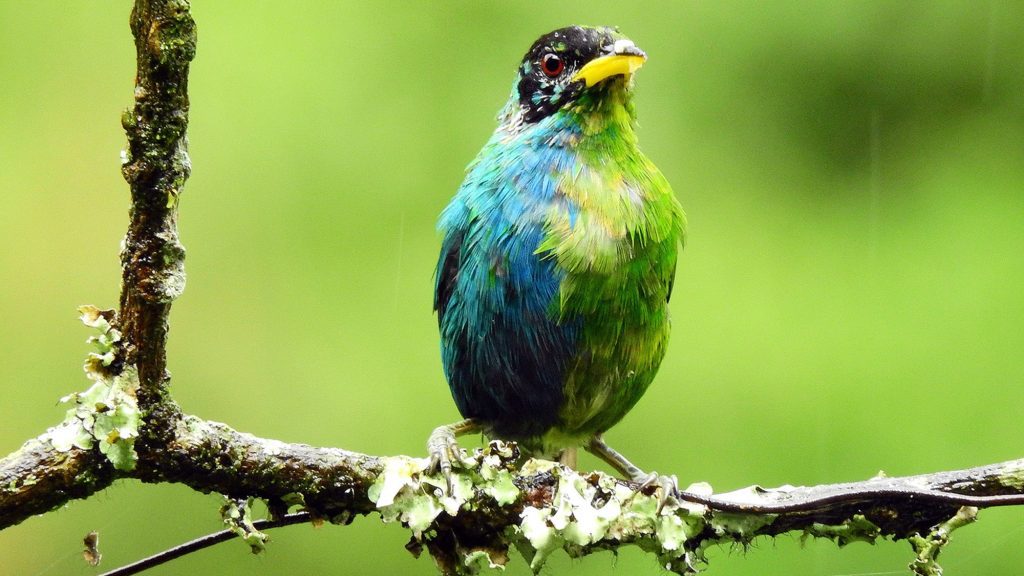What is the most unusual thing you discovered this week? No matter what it is, we assure you that you will get an even weirder response if you listen to PopSci’s hit podcast. The Weirdest Thing I Learned This Week hits Apple, Spotify, YouTube, as well as on other podcast platforms every other Wednesday morning. It's your new favorite source for the most peculiar science-related facts, figures, and Wikipedia rabbit holes from the editors of Popular Science . If you enjoy the stories in this post, we guarantee you'll enjoy the show.
Check out Weirdest Thing's new Reddit page to connect with other unusual people!
FACT: These birds challenge the concepts of male and female effortlessly
By Amanda Reed
Hamish Spencer, a zoologist and distinguished professor at the University of Otago, was on vacation in Colombia when ornithologist John Murillo pointed out an interesting bird perched on a feeding station. The bird in question was a green honeycreeper, but it looked different from any other honeycreeper they'd seen before. The right half of the bird was blue, similar to the males of the species, and the left half was green—the color usually seen in females.
This unique honeycreeper is one of many animals that exhibit bilateral gynandromorphism, a characteristic where animals show both male and female traits although their species typically have distinct sexes.
Other birds have also exhibited bilateral gynandromorphism. In 2019, a cardinal with male and female feathers was seen in Erie, Pennsylvania. In 2020, researchers in Pennsylvania discovered a gynandromorphic rose-breasted grosbeak displaying male feathers on the right and female feathers on the left.
These birds, along with other gender-defying animals such as clownfish and leaping lesbian lizards, prove that nature does not adhere to simple labels as much as you might think. For more about how the natural world consistently challenges our understanding of things like sex, take a look at these gene-stealing salamanders, this super-sexy slime mold, and Rachel's book about the unusual and amazing evolution of sex.
FACT: Frogs make a lot more noise than you'd expect
Litter leaf frogs, residents of the Brazilian rainforest, use a unique defense strategy: producing screams at frequencies beyond the range of human hearing. Recent research has shown that these unassuming amphibians use ultrasonic screams, which are indiscernible to human ears, to deter potential threats like bats and rodents. They also perform a quirky maneuver before unleashing their defensive cries.
So, why do these frogs scream? Well, scientists have a couple of theories. One idea is that they are attempting to scare off as many predators as possible by using a wide range of frequencies. Another notion is that the scream might actually attract other, larger predators to handle whatever is threatening the frog.
And in case you're wondering: yes, some frogs scream at frequencies that are completely audible to us, for better and for worse.
FACT: One scientist attempted to demonstrate that fungi could communicate (in a way)
Fungi come in various shapes and sizes, from the tiny organisms living in and around our bodies to the largest living entity on Earth: 3.5 square miles of Armillaria ostoyae found in an Oregon forestThere are many kinds of fungi, but if you're not a specialist, when you think of fungi, you likely think of mushrooms. Sometimes tasty, sometimes dangerous, sometimes mind-altering, mushrooms are the reproductive structures of specific fungi.
If you were wondering, “How can a fungus cover 3.5 square miles?!” The answer is the network of mycelium (consisting of long, underground filaments called hyphae) connecting fungal colonies with the soil, similar to how the nervous system links things in our bodies. Together, the mycelium makes up the mycorrhizal network that connects plants to share resources and communicate. It's often referred to as the wood wide web!
Similar to the internet, the wood wide web enables fungi to communicate, transferring nutrients, chemicals, and electrical signals. One scientist studied these electrical signals and asserts that mushrooms communicate with each other in 'words' resembling human language. You can discover more about these potentially chatty mushrooms by listening to this week’s episode.









